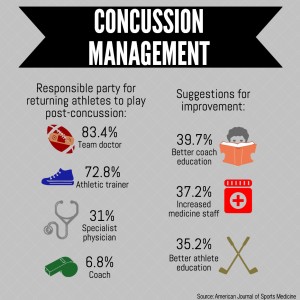
Most university athletic departments are in compliance with the NCAA concussion policy established in 2010, a Tuesday study from professors at Boston University and Harvard University found.
The study surveyed all 1,066 institutions in the NCAA, and 907 responded to the request. Approximately 82.1 percent of schools that responded said they had a concussion management plan in place and are in compliance with the guidelines delineated by the NCAA 2010 law.
“We wanted to be able to tell whether or not people are actually implementing the NCAA concussion policy,” said Daniel Daneshvar, postdoctoral researcher at BU and one of the authors of the study. “What we did is survey coaches and people involved in athletic training and sport medicine personnel, as well as athletic directors, to determine whether or not these components of the NCAA policy were in fact being done.”
The 2010 NCAA concussion policy states that concussion management plans include comprehensive educational material for athletes and that athletes should participate in a one-time pre-participation baseline concussion assessment, according to the NCAA website.
Athletes experiencing concussion symptoms must be removed from practice or competition, be referred to a physician or athletic trainer and appropriate precautions must be taken post concussion, the website states.
Emily Kroshus, postdoctoral student at Harvard and another author of the study, said there are still clear areas where improvement is needed.
“Only around three-quarters of institutions provide concussion education to athletes,” she said in an email. “Figuring out how to increase compliance with NCAA concussion policy is a challenging proposition, but it something that all stakeholders, including the member institutions who all vote on NCAA policy, need to take seriously.”
Leonard Glantz, one of the authors of the study and professor in the School of Public Health at BU, said the coaches and clinicians had different ideas about which methods of improvements would be most effective.
The study found that only 29 percent of coaches thought more comprehensive coach education would be an effective way to improve management plans, while 60 percent of clinicians thought coach education would be an effective solution. Thirty-seven percent of coaches identified athlete education as a solution, while 42 percent of clinicians thought this would be an effective means of improvement, according to the study.
Glantz said there is ambiguity surrounding the meaning of athlete education. He said one school might hand out a flyer and call that athlete education, while another might have more thorough education plans.
“What it concludes is that most of these schools have policies, and most of them abide by the policies,” he said. “We see that there were some real differences from school to school. Whether or not people know that there are policies, whether or not they know what the policy says and it varies.”
BU Senior Athletic Trainer Brian Vesci said BU complies with the guidelines set forth by the NCAA. Baseline tests are administered yearly in addition, and a number of other actions are taken.
“Other things incorporated in that have to do with educating individuals on a yearly basis,” he said. “The way in which we do that is meet with them as a team and talk to them about the symptoms of concussions, the importance of why they should report not just them but also teammates or friends that they know that may have suffered or are experiencing symptoms so that they can be evaluated.”
Vesci said he could identify areas where BU’s concussion management plan could be improved.
“I don’t think there’s a component of it that we are necessarily missing, but I think there can be enhancements in some of the application,” he said.
Vesci also said he has recently seen an increase in the number of concussion injuries being reported at BU.
“I’ve definitely seen an anecdotal trend upward of reporting,” he said. “I don’t know if that directly has to do with what we’re doing or if that has to do with the increased awareness just in the world in general about the effects of injuries.”



















































































































Malorie Boughan • Mar 10, 2016 at 6:51 pm
Greetings! Very helpful advice within this article! It’s the little changes which will make the most important changes. Thanks for sharing!